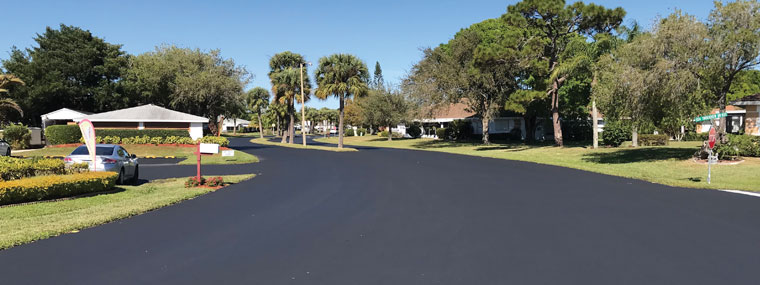
HOA Reserve Analysts Reduce Funds Required to Maintain Pavement Assets
By Mark Beatty / Published July 2023

Utilizing the information discussed in this article has significantly reduced the financial burden placed on HOAs as they manage pavement assets. I was asked to summarize some of the key points of an interview with the co-owners of a successful reserve study firm in which they focused on pavement management strategy. Ultimately their motivation was to lower the costs of owning private streets and parking lots.
I’ll say it right up front, some of the statements from Carl and Tom Thompson may sound like they represent a product or service for asphalt preservation. How-ever, the co-owners of Advanced Reserve Solutions of Arizona have absolutely no financial incentive to recommend one surface treatment versus another other than to offer the most beneficial and responsible financial reserve analysis possible.
Carl describes the business this way: “Our primary operation is offering reserve studies for HOAs or really any common interest development. We create long-term budgets for them by providing reports and aiding community management companies with the preparation of budgets.”
Tom states, “I would say on average the majority of associations are not well funded. Budgets are so tight that they have difficulty in getting their reserve contributions to the appropriate level. When you have increases in general operating costs like electricity, water, and insurance, to name a few, you know the dollars seem to go there, and the reserve accounts are often neglected.”
To combat this lack of funding that HOAs are consistently saddled with, Carl and Tom are directing clients to a pavement preservation method that is effectively extending the useful life of community streets. This extension in pavement life changes the ownership costs and financial burden placed upon private communities as streets are often one of the most, if not the most, expensive assets for an HOA to manage.
Regarding budgeted amounts Carl emphatically comments, “What were previously being budgeted for…asphalt rehabilitation projects…just aren’t needed anymore with the use of [the] product.”
Over a decade ago these business owners were skeptical of what they were told initially about an asphalt preservation treatment. The preservation treatment most commonly known as HA5 had only recently been used in their region, so it was suggested that they look at installations the next time that they were in the Las Vegas area. Within a few months Carl was visiting Las Vegas and decided he’d go take a look at an installation of HA5, which is classified as a High Density Mineral Bond. He was given a community to go look at and thought it looked like a seal coat that was maybe a couple of years old. When Carl learned it was six years old and he could see that it was still performing well, he realized that it was something they were going to need to learn more about because of how this would impact their reserve studies.

On the left is HA5 and on the right seal coat—side-by-side installations at The Villages, Florida. Picture taken two years after each were installed.
Carl says, “That’s when we first started to believe that it’s a game changer in the industry, and there’s a reason why it comes with a five-year warranty. So we were beginning our understanding of what it was and how we need to treat it in a reserve study.”
Over the years as Carl and Tom had become more familiar with installations of HA5, their reserve studies have evolved to push back the need for major rehabilitation or replacement. Carl commented that they are being less and less aggressive with replacement projections due to the increased projected life span of the asphalt paving assets in a community.
Tom says, “We get a ton of questions about long-term budgeting plans, and we do our best to explain the financial side. We’re not well versed in all the technical aspects of HA5 and all the chemical makeup, but what we do understand is how it will affect the long-term planning for these associations. It’s all based upon the evidence that we’ve seen physically on the ground, and we’ve seen eight-year-old HA5 and how it still performs. We’ve seen the two-year seal coat and how it often doesn’t perform.
Tom continues, “We take that visual evidence we’ve seen and start to turn that into a financial budgeting model that allows the boards to start making educated decisions about what it is that they should be considering. If they choose to go down the road [of using HA5], we can provide them with a long-term plan that identifies what those savings will be.”
Carl adds, “What we will typically do is the standard in our industry. For so long it has been that you do a seal coat program unless you’re doing some other type of rehabilitative measure… But your standard maintenance program is with a seal coat, and so that’s the standard thing that goes in our reserve studies with a side note.” What’s included in this sidenote is information making boards aware that an alternative, HA5, is recommended for consideration when the pavement conditions are appropriate. Carl states the reason for the sidenote is “because the long-term benefits of it are significant [and] most HOA boards don’t want to raise dues. The biggest pushback we get regarding a reserve study is you’re requiring or suggesting that we raise our dues in order to fund the reserves at the rate that you’re recommending, and HOAs don’t want to do that.”
Carl states, “We understand that. We do our best to provide reserve studies that don’t require increases to reserves above and beyond a normal inflationary factor if we can provide a funding strategy that meets the criteria we have. What we do is offer them the ability to have a secondary reserve study done that incorporates an HA5 maintenance program. [With] a side-by-side look at here’s my seal coat program and here’s my HA5 program, you can see long term what the funding requirements are.”
He continues, “In the short term, it’s not necessarily less because the HA5 is a more expensive sealing product. But when you’re only doing it every eight years as opposed to every three to four years for a seal coat, you start to see significant savings 5, 10, and 15 years down the road. Then with the elimination of a full rehabilitation of the asphalt at the 25 to 40-year mark, that’s where you really see the significant savings because the HA5 is retarding the degradation of the asphalt.”
Mark Beatty
Senior Vice President, Holbrook Asphalt Company
Mark Beatty is on the Advisory Board for the International Pavement Management Association and consults with public agencies and HOAs throughout the U.S. He is a sought-after presenter at public works events as well as HOA seminars. Mark serves as the Sr. Vice President at Holbrook Asphalt Company. You can contact Mark at mark@holbrookasphalt.com.





